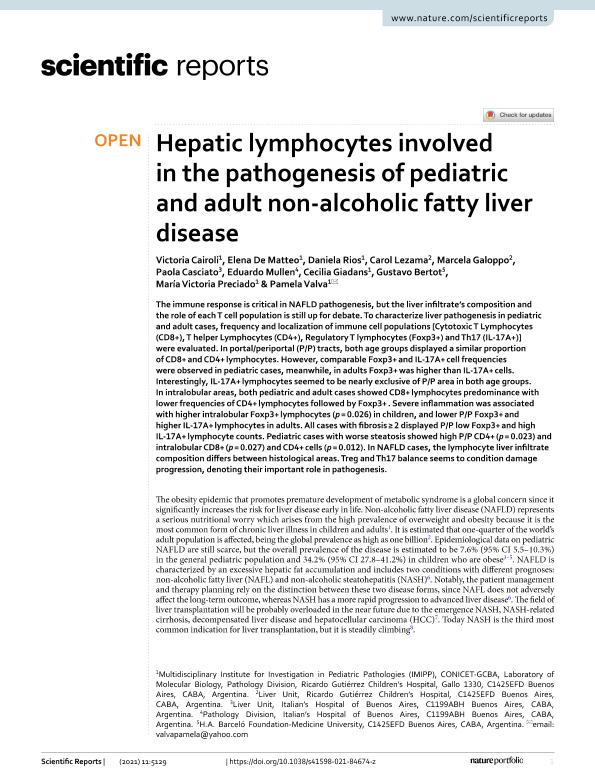Artículo
Hepatic lymphocytes involved in the pathogenesis of pediatric and adult non-alcoholic fatty liver disease
Cairoli, Victoria; de Matteo, Elena Noemí ; Rios, Daniela Alejandra
; Rios, Daniela Alejandra ; Lezama, Carol; Galoppo, Marcela; Casciato, Paola
; Lezama, Carol; Galoppo, Marcela; Casciato, Paola ; Mullen, Eduardo; Giadans, Cecilia Graciela
; Mullen, Eduardo; Giadans, Cecilia Graciela ; Bertot, Gustavo; Preciado, María Victoria
; Bertot, Gustavo; Preciado, María Victoria ; Valva, Pamela
; Valva, Pamela
 ; Rios, Daniela Alejandra
; Rios, Daniela Alejandra ; Lezama, Carol; Galoppo, Marcela; Casciato, Paola
; Lezama, Carol; Galoppo, Marcela; Casciato, Paola ; Mullen, Eduardo; Giadans, Cecilia Graciela
; Mullen, Eduardo; Giadans, Cecilia Graciela ; Bertot, Gustavo; Preciado, María Victoria
; Bertot, Gustavo; Preciado, María Victoria ; Valva, Pamela
; Valva, Pamela
Fecha de publicación:
12/2021
Editorial:
Nature Publishing Group
Revista:
Scientific Reports
e-ISSN:
2045-2322
Idioma:
Inglés
Tipo de recurso:
Artículo publicado
Clasificación temática:
Resumen
The immune response is critical in NAFLD pathogenesis, but the liver infiltrate’s composition and the role of each T cell population is still up for debate. To characterize liver pathogenesis in pediatric and adult cases, frequency and localization of immune cell populations [Cytotoxic T Lymphocytes (CD8+), T helper Lymphocytes (CD4+), Regulatory T lymphocytes (Foxp3+) and Th17 (IL-17A+)] were evaluated. In portal/periportal (P/P) tracts, both age groups displayed a similar proportion of CD8+ and CD4+ lymphocytes. However, comparable Foxp3+ and IL-17A+ cell frequencies were observed in pediatric cases, meanwhile, in adults Foxp3+ was higher than IL-17A+ cells. Interestingly, IL-17A+ lymphocytes seemed to be nearly exclusive of P/P area in both age groups. In intralobular areas, both pediatric and adult cases showed CD8+ lymphocytes predominance with lower frequencies of CD4+ lymphocytes followed by Foxp3+. Severe inflammation was associated with higher intralobular Foxp3+ lymphocytes (p = 0.026) in children, and lower P/P Foxp3+ and higher IL-17A+ lymphocytes in adults. All cases with fibrosis ≥ 2 displayed P/P low Foxp3+ and high IL-17A+ lymphocyte counts. Pediatric cases with worse steatosis showed high P/P CD4+ (p = 0.023) and intralobular CD8+ (p = 0.027) and CD4+ cells (p = 0.012). In NAFLD cases, the lymphocyte liver infiltrate composition differs between histological areas. Treg and Th17 balance seems to condition damage progression, denoting their important role in pathogenesis.
Palabras clave:
NAFLD
,
T cell population
,
Pathogenesis
Archivos asociados
Licencia
Identificadores
Colecciones
Articulos(IMIPP)
Articulos de INSTITUTO MULTIDISCIPLINARIO DE INVESTIGACIONES EN PATOLOGIAS PEDIATRICAS
Articulos de INSTITUTO MULTIDISCIPLINARIO DE INVESTIGACIONES EN PATOLOGIAS PEDIATRICAS
Citación
Cairoli, Victoria; de Matteo, Elena Noemí; Rios, Daniela Alejandra; Lezama, Carol; Galoppo, Marcela; et al.; Hepatic lymphocytes involved in the pathogenesis of pediatric and adult non-alcoholic fatty liver disease; Nature Publishing Group; Scientific Reports; 11; 1; 12-2021
Compartir
Altmétricas



